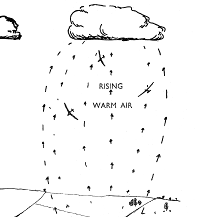Learn the fundamentals
of gliding
What is Gliding?
Broadly, what you want it to be. The simple definition is that a glider is an aircraft that instead of using engine power to prevent it from descending gently to the ground, can be kept airborne by the pilot finding rising air. Staying up using only the lift available in the atmosphere is what we mean by ‘soaring’.
Any pilot who has been sufficiently trained to fly on his own will have acquired the skills to stay airborne during a typical fine summer day. What you do after that depends on you. Some pilots simply continue to enjoy the experience of being airborne. On a sunny weekend afternoon this may mean an hour or two flying comfortably within a few miles of the home airfield.
More adventurous pilots may want to fly cross-country away from their home site. A typical cross-country flight will consist of a series of climbs and glides heading away from the site, and then, when it’s time to turn round the same thing coming back. Very occasionally the lift fails, and then a landing in a field follows, followed by a phone call and a retrieve with car and trailer.
Those who enjoy a real challenge and want to hone their skills can fly in competitions, racing other pilots round a fixed course. And, if that’s what floats your boat, we can provide aerobatics training.
What Keeps a Glider Airborne?
Click on the + icons below to learn more.


Getting in the Air
There are two commonly used methods of launching
Aerotow
The most versatile of the launch methods is by aerotow, where the glider is towed up, usually to around 2000 feet. On a good day this is enough to reach the thermals and ‘get away’.
Also, a good tug pilot will tow the glider to where the lift is best. This is particularly important for soaring in wave lift, as it’s often necessary to get to above 3000 ft, and quite possibly 2-3 miles from the airfield, to get into this type of rising air currents.
Winching
A more economical way of getting into the air is behind a winch. Instead of expensive aviation fuel, winches run on diesel, and the cost of the launch is about a quarter of what it would be by aerotow. However, winch launches only go to around 900- 1400 feet (depending on how much headwind there is). So, more skill (or luck) is needed to get into lift.
One advantage of the winch is that it can be very cost-effective at certain stages of training, for example when the pupil is mastering the pre-landing circuits and the landing itself.
